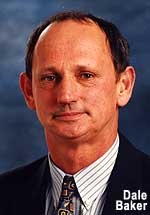|
November 24, 2003
With more
than $4 million invested in climate variability and risk
assessment projects over the next six years, the
Grains Research and Development
Corporation (GRDC) is helping growers better manage climate
change and seasonal weather variation.
The 10
projects cover, among other things, climate change and long-lead
seasonal and cropping forecasts, including for wheat yield and
protein and cropping risks.
CSIRO’s Dr Senthold Asseng, for example, is testing the southern
oscillation index, sea surface temperature and mid-latitude
forecasting indices for their potential use in
Western Australia,
before connecting them to crop models predicting wheat yield and
protein.
A Western Australia
Department of Agriculture project seeks a clearer understanding
of climate change projections and impacts on wheat production
and quality at a regional level in Western Australia.
 According
to GRDC Western Panel Chairman and Hyden farmer, Dale Baker,
this should encourage the grains industry to better plan and
adapt to climate change. According
to GRDC Western Panel Chairman and Hyden farmer, Dale Baker,
this should encourage the grains industry to better plan and
adapt to climate change.
Another three year $400,000 plus Department project, supported
by the GRDC’s western and southern panels, is investigating
better long-lead seasonal and crop forecasts for southern
Australia.
Dr David Stephens and his team aim to define the major weather
processes driving climate extremes, with emphasis on weather
systems affecting southern Australia.
The project will also attempt to validate the Department’s WA
seasonal climate indices and develop an integrated climate and
yield forecasting product.
Mr Baker, who is also
Chairman of
the Managing Climate Variability Program, which recently secured
an additional $500,000 from the federal government for climate
research, said a big challenge for growers was how best to
maximize benefits from good years, while minimizing the impact
of bad seasons.
“In
Western Australia,
this bumper season provides a classic contrast with last year,
which was ravaged by drought. We need to learn lessons from both
and have tools in place for next season to better manage the
climate and weather scenarios we will face,” he said.
|